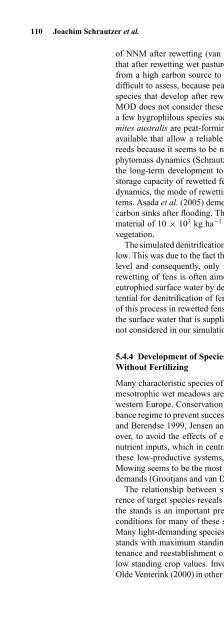Linking Restoration and Ecological Succession (Springer ... - Inecol
Linking Restoration and Ecological Succession (Springer ... - Inecol
Linking Restoration and Ecological Succession (Springer ... - Inecol
You also want an ePaper? Increase the reach of your titles
YUMPU automatically turns print PDFs into web optimized ePapers that Google loves.
110 Joachim Schrautzer et al.<br />
of NNM after rewetting (van Dijk et al. 2004). The simulation results show<br />
that after rewetting wet pastures, a major change occurs in the carbon budget<br />
from a high carbon source to a carbon sink. How far the latter is realistic is<br />
difficult to assess, because peat-forming processes are dependent on the plant<br />
species that develop after rewetting (Roth et. al 1999) <strong>and</strong> the model WAS-<br />
MOD does not consider these aspects. According to Roth et al. (1999), only<br />
a few hygrophilous species such as Carex elata, Carex acutiformis, or Phragmites<br />
australis are peat-forming species. On the other h<strong>and</strong>, there are no data<br />
available that allow a reliable calculation of the carbon budget of tall sedge<br />
reeds because it seems to be nearly impossible to measure their belowground<br />
phytomass dynamics (Schrautzer 2004). Nevertheless, it can be assumed that<br />
the long-term development to eutrophic alder carrs will enhance the carbon<br />
storage capacity of rewetted fens (Kutsch et al. 2000). Apart from vegetation<br />
dynamics, the mode of rewetting also influences the carbon budget of the systems.<br />
Asada et al. (2005) demonstrated that dry peatl<strong>and</strong>s might be changed to<br />
carbon sinks after flooding. The authors measured an accumulation of organic<br />
material of 10 × 10 3 kg ha −1 during a period of 9 years in areas with marsh<br />
vegetation.<br />
The simulated denitrification rates of the rewetted ecosystems were relatively<br />
low. This was due to the fact that the simulation was carried out only at the site<br />
level <strong>and</strong> consequently, only internal processes were represented. However,<br />
rewetting of fens is often aimed at the reduction of nitrate concentrations of<br />
eutrophied surface water by denitrification (Leonardsson et al. 1994). The potential<br />
for denitrification of fen ecosystems is high <strong>and</strong> therefore the intensity<br />
of this process in rewetted fens depends mainly on the nitrate concentration of<br />
the surface water that is supplied (Davidsson et al. 2002). These aspects were<br />
not considered in our simulation.<br />
5.4.4 Development of Species Richness After Mowing<br />
Without Fertilizing<br />
Many characteristic species of seminatural fens such as small sedge reeds <strong>and</strong><br />
mesotrophic wet meadows are missing in the agricultural l<strong>and</strong>scape of northwestern<br />
Europe. Conservation of these species depends on a moderate disturbance<br />
regime to prevent successional changes caused by ab<strong>and</strong>onment (Bakker<br />
<strong>and</strong> Berendse 1999, Jensen <strong>and</strong> Schrautzer 1999, Diemer et al. 2001). Moreover,<br />
to avoid the effects of eutrophication on species composition, external<br />
nutrient inputs, which in central Europe usually exceed the natural outputs of<br />
these low-productive systems, have to be controlled (Olde Venterink 2000).<br />
Mowing seems to be the most successful management measure to fulfill these<br />
dem<strong>and</strong>s (Grootjans <strong>and</strong> van Diggelen 1995; see Chapter 6).<br />
The relationship between st<strong>and</strong>ing crop, light availability, <strong>and</strong> the occurrence<br />
of target species reveals that a specific (“target”) biomass production of<br />
the st<strong>and</strong>s is an important prerequisite to maintain or create suitable habitat<br />
conditions for many of these species (cf. Kotowski <strong>and</strong> van Diggelen 2004).<br />
Many light-dem<strong>and</strong>ing species of the Scheuchzerio-Caricetea occur mainly in<br />
st<strong>and</strong>s with maximum st<strong>and</strong>ing crop values below 400 g m −2 , but the maintenance<br />
<strong>and</strong> reestablishment of most Molinietalia species do not require such<br />
low st<strong>and</strong>ing crop values. Investigations of Güsewell <strong>and</strong> Klötzli (1998) <strong>and</strong><br />
Olde Venterink (2000) in other northwestern European fens as well as studies in

















